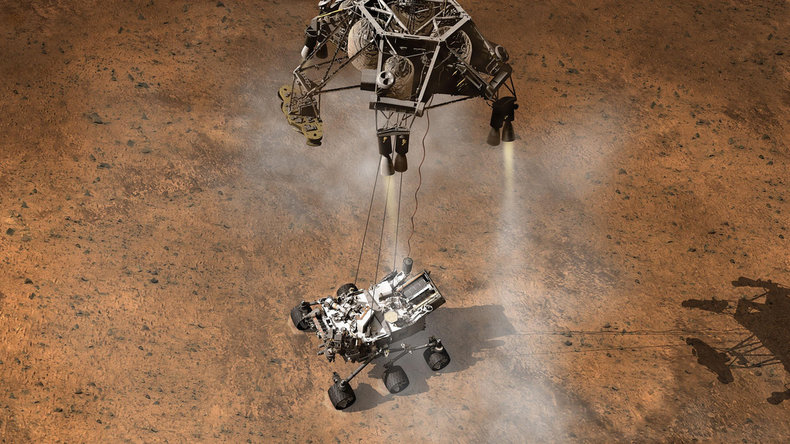
 |
A-Z | Popular | Blog | Space | Search » |
|
top
»
science
»
space
»
spacecraft
26 Types of Spacecraft John Spacey, updated on
 Atmospheric ProbeAn unmanned machine designed to enter the atmosphere of an alien planet.Bussard RamjetA theoretical type of spacecraft that would drive propulsion using large scale electromagnetic fields to collect and compress hydrogen from space. Although space is mostly empty, it does contain particles such as those generated by the solar wind.Dyson SphereA sphere that completely encloses a star in order to capture all of its energy. Some of this energy could potentially be used to propel the structure through space as a moving megastructure. A Dyson Sphere around our sun would generate 33 trillion times the world's current annual energy consumption.Flyby SpacecraftA spacecraft designed to approach planets but not be captured by their orbit or land. They generally either follow a solar orbit or eventually escape the solar system.Generation ShipA ship designed with an artificial environment large enough for a small society to sustain itself for multiple generations. The Milk Way galaxy is at least 150,000 light years in diameter and even at the speed of light, interstellar travel can potentially take thousands of years.Interplanetary SpacecraftA spacecraft capable of reaching planets in the solar system.Interstellar SpacecraftA spacecraft capable of reaching another solar system. The closest solar system to our own, Alpha Centauri, is 4.37 light-years from the sun. Using current technologies it might take hundreds of years to reach and cost several orders of magnitude more than a interplanetary spacecraft.LanderA craft that is capable of landing on an alien surface such as a planet, moon or asteroid.Magnetic SailA proposed method of propulsion that uses a static magnetic field that is pushed by forces such as the solar wind, planetary magnetospheres or the very small amounts of hydrogen found in interstellar space.Manned SpacecraftA spacecraft with a crew and/or passengers.MothershipA large spacecraft that serves, launches or is served by smaller spacecraft known as tenders.NanoprobesSmall spacecraft built at nanoscale are a potential way to explore vast regions of space at a minimal cost. If mass produced, such craft might benefit from economies of scale.OrbiterA spacecraft designed to achieve orbit around a planet. Requires the ability to slow down enough not to escape orbit as it passes.Penetrator SpacecraftA craft designed to withstand impact with a body such as a comet in order to study its interior.Rover SpacecraftA vehicle designed for an alien surface such as a planet or moon.SatelliteA class of unmanned spacecraft typically deployed in orbit around the Earth with communications, information technology, observational and research capabilities. Around one thousand satellites are currently in operation.Self-Replicating SpacecraftA spacecraft designed to collect energy and materials in space in order to create copies of itself. In theory, the descendants of a single probe could explore the entire galaxy.Sleeper ShipA manned ship with a crew that is put into a state of hibernation or suspended animation to prevent or slow aging for interstellar missions of decades or more in duration.Solar OrbiterA craft that orbits a star.Solar SailsA method of propulsion that uses a physical mirror-like sail designed to be pushed by light emitted by stars or laser beams.Space CapsuleA spacecraft with a simple shape without wings to create lift during atmospheric reentry. Typically lands with the use of parachute.Space ElevatorA cable that extends from Earth to a geostationary satellite that can be climbed by vehicles in order to achieve orbit. Potentially reduces the energy required to escape the Earth's gravity.Space StationA spacecraft capable of supporting a crew for an extended period of time. Often constructed in space without major propulsion systems or any ability to land.SpaceplaneA craft that can fly in Earth's atmosphere using lift and then transition to flight in space where lift isn't possible.Stanford TorusA donut-shaped space habitat designed to produce artificial gravity by rotating to create centrifugal force.Stellar EnginesUsing a star as an engine for propulsion. Potentially ethically questionable as it reconfigures the universe and may have a dramatic impact on the space environment.SpaceThis is the complete list of articles we have written about space.If you enjoyed this page, please consider bookmarking Simplicable.
Fermi ParadoxThe Fermi Paradox explained.Piggyback
An overview of piggybacks in transportation.
Orbit
The common types of orbit.
Speed Of Light
An overview of the speed of light with examples.
Space Industry
An overview of the space industry with examples.
Inertia
The definition of inertia with examples.
Electromagnetic SpectrumAn overview of the common wavelengths of the electromagnetic spectrum.PhysicsA list of the branches of physics.Space ThingsA list of astronomical objects and phenomenon.Robotics vs Artificial Intelligence
The different between robots and AI.
Vertical Farming
An overview of vertical farming.
Superintelligence
An overview of superintelligence.
Yobibyte
A definition of yobibyte with a chart of comparisons to other data sizes.
Artificial Intelligence Examples
Common examples of artificial intelligence.
Technology Examples
The definition of technology with examples.
Technology TheoryA list of interesting technology theories.
Technology ChangeAn overview of technology change with examples.
TrendingThe most popular articles on Simplicable in the past day.New ArticlesRecent posts or updates on Simplicable. Site Map
© 2010-2023 Simplicable. All Rights Reserved. Reproduction of materials found on this site, in any form, without explicit permission is prohibited. View credits & copyrights or citation information for this page. |